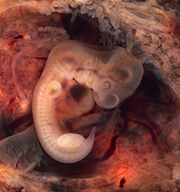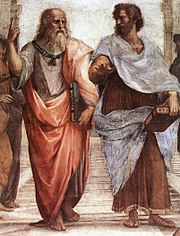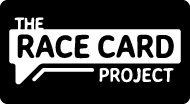History
Evolution
The scientific study of human evolution encompasses the development of the genus Homo, but usually involves studying other hominids and hominines as well, such as Australopithecus. "Modern humans" are defined as the Homo sapiens species, of which the only extant subspecies is Homo sapiens sapiens; Homo sapiens idaltu (roughly translated as "elder wise man"), the other known subspecies, is extinct. Anatomically modern humans appear in the fossil record in Africa about 200,000 years ago.
The closest living relatives of Homo sapiens are the Common Chimpanzee and the Bonobo. Full genome sequencing resulted in the conclusion that "after 6.5 [million] years of separate evolution, the differences between chimpanzee and human are just 10 times greater than those between two unrelated people and 10 times less than those between rats and mice". In fact, 95% of the DNA sequence is identical between chimpanzee and human. It has been estimated that the human lineage diverged from that of chimpanzees about five million years ago, and from gorillas about eight million years ago. However, a hominid skull discovered in Chad in 2001, classified as Sahelanthropus tchadensis, is approximately seven million years old, which may indicate an earlier divergence.
There are two prominent scientific theories of the origins of contemporary humans. They concern the relationship between modern humans and other hominids. The single-origin, or "out-of-Africa", hypothesis proposes that modern humans evolved in Africa and later migrated outwards to replace hominids in other parts of the world. The multiregional hypothesis, on the other hand, proposes that modern humans evolved, at least in part, from independent hominid populations.
Geneticists Lynn Jorde and Henry Harpending of the University of Utah proposed that the variation in human DNA is minute compared to that of other species, and that during the Late Pleistocene, the human population was reduced to a small number of breeding pairs—no more than 10,000 and possibly as few as 1,000—resulting in a very small residual gene pool. Various reasons for this hypothetical bottleneck have been postulated, the most popular being the Toba catastrophe theory.
Human evolution is characterized by a number of important physiological trends, including the expansion of the brain cavity and brain itself, which is typically 1,400 cm³ in volume, over twice that of a chimpanzee or gorilla. The pattern of human postnatal brain growth differs from that of other apes (heterochrony), allowing for an extended period of social learning and language acquisition in juvenile humans. Physical anthropologists argue that a reorganization of the structure of the brain is more important than cranial expansion itself. Other significant evolutionary changes included a reduction of the canine tooth, development of bipedal locomotion, and the descent of the larynx and hyoid bone, making speech possible. How these trends are related and what their role is in the evolution of complex social organization and culture are matters of ongoing debate.
Rise of civilization
The most widely accepted view among current anthropologists is that Homo sapiens originated in the African savanna around 200,000 years ago, descending from Homo erectus, and colonized Eurasia and Oceania by 40,000 years ago, and finally colonized the Americas by 10,000 years ago. They displaced Homo neanderthalensis and other species descended from Homo erectus (which had colonized Eurasia as early as 2 million years ago) through more successful reproduction and competition for resources.
The earliest humans were hunter-gatherers, a lifestyle well-suited to the savanna. They generally lived in small, nomadic groups. Around 10,000 years ago, the advent of agriculture prompted the Neolithic Revolution. Access to a stable food source led to the formation of permanent human settlements, the domestication of animals, and the use of metal tools. Agriculture also encouraged trade and cooperation, leading to complex societies. Villages developed into thriving civilizations in regions such as the Middle East's Fertile Crescent.
Around 6,000 years ago, the first states developed in Mesopotamia, Egypt and the Indus Valley. Military forces were formed for protection, and government bureaucracies for administration. States cooperated and competed for resources, in some cases waging wars. Around 2,000–3,000 years ago, some states, such as Persia, China, and Rome, developed through conquest into the first expansive empires. Influential religions, such as the Abrahamic and Dharmic religions, also rose to prominence at this time.
The late Middle Ages saw the rise of revolutionary ideas and technologies. In China, an advanced and urbanized economy promoted innovations such as printing and the compass, while the Islamic Golden Age saw major scientific advancements in Muslim empires. In Europe, the rediscovery of classical learning and inventions such as the printing press led to the Renaissance in the 14th century. Over the next 500 years, exploration and imperialistic conquest brought much of the Americas, Asia, and Africa under European control, leading to later struggles for independence. The Scientific Revolution in the 17th century and the Industrial Revolution in the 18th–19th centuries promoted major innovations in transport, such as the railway and automobile, energy development, such as coal and electricity, and government, such as democracy and communism.
As a result of such changes, modern humans live in a world that has become increasingly globalized and interconnected. Although this has encouraged the growth of science, art, and technology, it has also led to culture clashes, the development and use of weapons of mass destruction, and increased environmental destruction and pollution. |
|
|
| Culture
Culture is defined here as a set of distinctive material, intellectual, emotional, and spiritual features of a social group, including art, literature, lifestyles, value systems, traditions, rituals, and beliefs. The link between human biology and human behavior and culture is often very close, making it difficult to clearly divide topics into one area or the other; as such, the placement of some subjects may be based primarily on convention.
Culture consists of values, social norms, and artifacts. A culture's values define what it holds to be important or ethical. Closely linked are norms, expectations of how people ought to behave, bound by tradition. Artifacts, or "material culture", are objects derived from the culture's values, norms, and understanding of the world.
Language
The capacity humans have to transfer concepts, ideas and notions through speech and writing is unrivaled in known species. The faculty of speech is a defining feature of humanity, possibly predating phylogenetic separation of the modern population (see origin of language). Language is central to the communication between humans, as well as being central to the sense of identity that unites nations, cultures and ethnic groups.
The invention of writing systems around 5000 years ago allowed the preservation of language on material objects, and was a major step in cultural evolution. Language is closely tied to ritual and religion (c.f. mantra, sacred text).
The science of linguistics describes the structure of language and the relationship between languages. There are approximately 6,000 different languages currently in use, including sign languages, and many thousands more that are considered extinct.
Art, music and literature
Artistic works have existed for almost as long as humankind, from early pre-historic art to contemporary art. Art is one of the most unusual aspects of human behavior and a key distinguishing feature of humans from other species. As a form of cultural expression by humans, art may be defined by the pursuit of diversity and the usage of narratives of liberation and exploration (i.e. art history, art criticism, and art theory) to mediate its boundaries. This distinction may be applied to objects or performances, current or historical, and its prestige extends to those who made, found, exhibit, or own them.
In the modern use of the word, art is commonly understood to be the process or result of making material works which, from concept to creation, adhere to the "creative impulse"—that is, art is distinguished from other works by being in large part unprompted by necessity, by biological drive, or by any undisciplined pursuit of recreation.
Music is a natural intuitive phenomenon based on the three distinct and interrelated organization structures of rhythm, harmony, and melody. Listening to music is perhaps the most common and universal form of entertainment for humans, while learning and understanding it are popular disciplines. There are a wide variety of music genres and ethnic musics.
Literature, the body of written—and possibly oral—works, especially creative ones, includes prose, poetry and drama, both fiction and non-fiction. Literature includes such genres as epic, legend, myth, ballad, and folklore.
Spirituality and religion
Spirituality, belief or involvement in matters of the soul or spirit, is one of the many different approaches humans take in trying to answer fundamental questions about mankind's place in the universe, the meaning of life, and the ideal way to live one's life. Though these topics have also been addressed by philosophy, and to some extent by science, spirituality is unique in that it focuses on mystical or supernatural concepts such as karma and God. However, critics would argue that spirituality does not actually answer any questions, and complicates the issues further by raising more questions.
A more organized, but related, concept is religion—sometimes used interchangeably with "faith"—which is commonly defined as a belief system concerning the supernatural, sacred, or divine, and the moral codes, practices, values, institutions and rituals associated with such belief. In the course of its development, religion has taken on many forms that vary by culture and individual perspective.
Some of the chief questions and issues religions are concerned with include life after death (commonly involving belief in an afterlife), the origin of life (the source of a variety of origin beliefs), the nature of the universe (religious cosmology) and its ultimate fate (eschatology), and what is moral or immoral. A common source in religions for answers to these questions are transcendent divine beings such as deities or a singular God, although not all religions are theistic—many are nontheistic or ambiguous on the topic, particularly among the Eastern religions.
Although a majority of humans profess some variety of spiritual or religious belief, some are irreligious, lacking or rejecting belief in the supernatural or spiritual. Additionally, although most religions and spiritual beliefs are clearly distinct from science on both a philosophical and methodological level, the two are not generally considered to be mutually exclusive; a majority of humans hold a mix of both scientific and religious views. The distinction between philosophy and religion, on the other hand, is at times less clear, and the two are linked in such fields as the philosophy of religion and theology |
|





